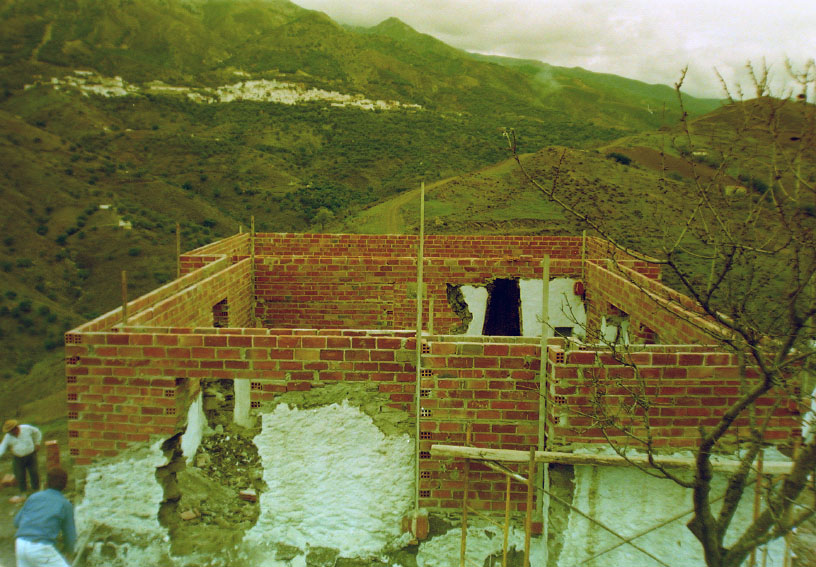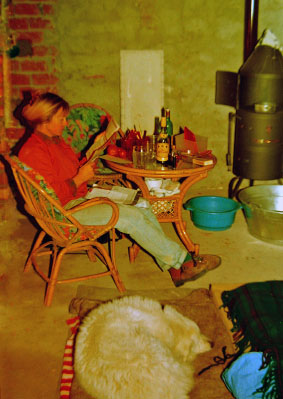For reasons which will no doubt form the basis of a separate post, about six months after completing our house in southern Spain we found ourselves living in a shabby rented apartment in a rundown part of Boulogne sur Mer on the north eastern tip of France.

Virtually penniless, we could not afford nor did we wish, to place our Maremma Sheepdog, Aura into the-then obligatory six-months of quarantine in Britain. We were in a pretty desperate situation, and if desperate situations require desperate measures, then the one we came up with was a genuine peach, although it did not seem so at the moment we conceived it.

Firstly, Dido took a job managing a paediatric occupational therapy department in Folkestone on the Kent coast, just a 40 minute Seacat (hydrofoil ferry) hop across the English Channel from Boulogne. Traveling as a foot passenger was cheap, and with a health-authority car provided at the English end, the daily journey would be both inexpensive and quicker than most commutes from the London suburbs into the City. It appeared to be totally reasonable solution to a tough problem; six months living frugally in a tatty loft then once we were more comfortably off, moving into a nicer flat in the charming old citadel above the port. Aura our dog was already 11 years old and towards the latter end of her life expectancy, and who was to know? Two or three years living in the charming quarter of an historic French town might actually be rather pleasant. The plan even seemed sufficiently foolproof that Dido need not disclose to her new bosses the fact she was living in France and risk their disapproval(the requirements for the post were that she lived within 30 miles of work… there were no stipulation as to whether the miles were measured across dry land or water). But then, to paraphrase a famous remark of a late British prime minister, “events” intervened to devastate our plans.

Having committed ourselves to the minimum six-month rental contract, we moved into our dingy lodgings the week before Dido was to start her new job. The flat was unfurnished, without even a kitchen, and so we spent the whole of the first few days madly rushing around in a rented van, using our credit cards to purchase the basic essentials to make the place habitable. Amongst other things, we got a type of sofa-bed (known as a clic-clac in France) and a tiny Baby Belling oven with a double hob. We couldn’t afford luxuries like refrigerators then, and still couldn’t afford one by the time we eventually left the flat at the end of the six months. Nevertheless, after we had scrubbed the flat half-a-dozen times and got our few pieces of furniture set up (including a table improvised from a lacquered MDF board) the place seemed habitable. That, in addition to the fact it was only a five minute walk from the Seacat dock gave us reason to think the next six months would be reasonably tolerable. However, it must have been the Thursday or the Friday when we made that walk down to the port for the first time since settling in that the bottom fell out of our world.

Without notice of any kind the Seacat company had cancelled all runs to Folkestone with immediate effect. Dido had talked to the ferry people just a week earlier—days before we had signed the contract on the flat—and they had made no mention of their plans to cut back their service. It seemed like a sick joke. We were now tied into living in Boulogne for six months, and the only morning and evening transport across the Channel anywhere near practicable for Dido’s requirements was a 40 minute drive up the coast at Calais. Moreover, the only affordable foot passenger service was on the regular ferry boats, which took-one-and-a-half- hours to Dover. Suddenly, Dido’s easy two-hour daily return journey, now with the commute to Calais and the 20-minute drive from Dover to Folkestone added to the mix, had mutated horribly into a return journey taking five hours—on a good day.

But, with no money, and Dido’s job starting on Monday she had no alternative but to do the Calais crossing.

As it happened, the commute turned out to be just one of the many grim and farcical components of what was to prove the most miserable period of our marriage—the details of which will be the subject of another future blog. Enough to say for now, that the France most people experience as tourists has little in common with the dingy, rough, criminal-infested street we inhabited during our sojourn in Boulogne sur Mer.

The origins of the pictures shown here, lie in my numerous walks on Boulogne beach with Aura and apart from being a modest nod to great Dutch painters like Jacob van Ruisdael, express both the blueness of my mood in Boulogne, and my ever-growing yearning to cross that 20-mile strip of water back to England…




















































